Antibody data
- Antibody Data
- Antigen structure
- References [3]
- Comments [0]
- Validations
- Immunocytochemistry [3]
- Other assay [3]
Submit
Validation data
Reference
Comment
Report error
- Product number
- PA5-55019 - Provider product page

- Provider
- Invitrogen Antibodies
- Product name
- MYO10 Polyclonal Antibody
- Antibody type
- Polyclonal
- Antigen
- Recombinant protein fragment
- Description
- Immunogen sequence: QRMKEQQELS LTEASLQKLQ ERRDQELRRL EEEACRAAQE FLESLNFDEI DECVRNIERS LSVGSEFSSE LAESACEEKP NFNFSQPYPE EEVDEGFEAD DDAFKDSPNP SEHGHSDQRT SGIRTSDDSS EEDPYMNDTV VPTSPSA Highest antigen sequence identity to the following orthologs: Mouse - 91%, Rat - 92%.
- Reactivity
- Human
- Host
- Rabbit
- Isotype
- IgG
- Vial size
- 100 μL
- Concentration
- 0.30 mg/mL
- Storage
- Store at 4°C short term. For long term storage, store at -20°C, avoiding freeze/thaw cycles.
Submitted references Phenotypic and Functional Alterations in Tunneling Nanotubes Formed by Glaucomatous Trabecular Meshwork Cells.
In situ molecular characterization of endoneurial microvessels that form the blood-nerve barrier in normal human adult peripheral nerves.
Myosin-X Silencing in the Trabecular Meshwork Suggests a Role for Tunneling Nanotubes in Outflow Regulation.
Sun YY, Bradley JM, Keller KE
Investigative ophthalmology & visual science 2019 Nov 1;60(14):4583-4595
Investigative ophthalmology & visual science 2019 Nov 1;60(14):4583-4595
In situ molecular characterization of endoneurial microvessels that form the blood-nerve barrier in normal human adult peripheral nerves.
Ouyang X, Dong C, Ubogu EE
Journal of the peripheral nervous system : JPNS 2019 Jun;24(2):195-206
Journal of the peripheral nervous system : JPNS 2019 Jun;24(2):195-206
Myosin-X Silencing in the Trabecular Meshwork Suggests a Role for Tunneling Nanotubes in Outflow Regulation.
Sun YY, Yang YF, Keller KE
Investigative ophthalmology & visual science 2019 Feb 1;60(2):843-851
Investigative ophthalmology & visual science 2019 Feb 1;60(2):843-851
No comments: Submit comment
Supportive validation
- Submitted by
- Invitrogen Antibodies (provider)
- Main image
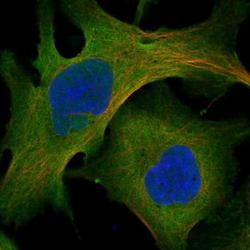
- Experimental details
- Immunofluorescent staining of MYO10 in human cell line U-2 OS shows positivity in nucleoli, plasma membrane & cytoplasm. Samples were probed using a MYO10 Polyclonal Antibody (Product # PA5-55019).
- Submitted by
- Invitrogen Antibodies (provider)
- Main image

- Experimental details
- Immunofluorescent staining of MYO10 in human cell line U-2 OS using a MYO10 Polyclonal Antibody (Product # PA5-55019) shows localization to plasma membrane and cytosol.
- Submitted by
- Invitrogen Antibodies (provider)
- Main image
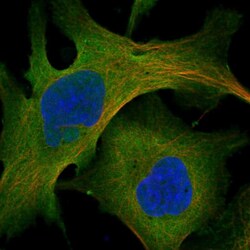
- Experimental details
- Immunofluorescent staining of MYO10 in human cell line U-2 OS using a MYO10 Polyclonal Antibody (Product # PA5-55019) shows localization to plasma membrane and cytosol.
Supportive validation
- Submitted by
- Invitrogen Antibodies (provider)
- Main image
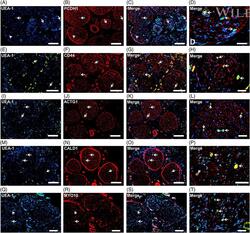
- Experimental details
- Peripheral nerve cell-specific structural proteins. Representative indirect fluorescent digital photomicrographs of cryostat axial sections of normal adult sural nerves show UEA-1-positive endothelial cells (green; A, E, I, M, Q) with expression of PCDH1, CD44, ACTG1, CALD1, and MYO10 (red; B, F, J, N, R, respectively) on endoneurial microvessels, fenestrated epineurial macrovessels, perineurium and Schwann cells (PCDH1) and axons (CD44, ACTG1, CALD1, and MYO10), shown in the merged images at lower and higher magnifications (yellow/orange for endothelial cells). Expression of these proteins by these cell types implies roles in maintaining the structural integrity of peripheral nerve-specific cells in normal adult nerves. White arrows demonstrate positively staining endoneurial microvessels. Blue (4, 6-diamidino-2-phenylindole) staining indicates nuclei. Scale bar 500 mum for A-C, E-G, I-K, M-O, and Q-S and 125 mum for D, H, L, P, and T
- Submitted by
- Invitrogen Antibodies (provider)
- Main image
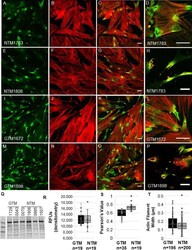
- Experimental details
- Figure 7 Myo10 protein distribution in NTM and GTM cells. Myo10 (green) and SiR-actin (red) in two NTM cell strains (A-G) and two GTM cell strains (I-O). Myo10 colocalized with cortactin in NTM cells (H) and GTM cells (P). Scale bars: 20 mum. (Q) Western immunoblotting showing Myo10 protein levels in GTM (n = 2) and NTM cells (n = 4). (R) Densitometry of Western immunoblots (n = 19 technical replicates) of GTM (n = 6 biologic replicates) and NTM (n = 9 biologic replicates). (S) Pearson's colocalization values of Myo10 and cortactin in GTM (n = 35) and NTM (n = 19) cells. (T) The diameter of actin stress fibers was calculated in GTM (n = 195) and NTM (n = 200) cells. *P = 0.0001.
- Submitted by
- Invitrogen Antibodies (provider)
- Main image
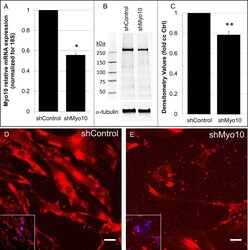
- Experimental details
- Figure 1 Generation of shRNA Myo10-silencing lentivirus (shMyo10) silencing lentivirus. Efficacy of Myo10 knockdown in human TM cells by infection with shMyo10-silencing lentivirus was tested by (A) quantitative RT-PCR using Myo10-specific primer sets. *P = 0.0001; n = 4 from 4 biological replicates. (B) Western immunoblotting of Myo10 with tubulin as a loading control and (C) densitometry of Myo10 knockdown. **P = 0.001; n = 7 from 5 biological replicates. Immunofluorescence of Myo10 in (D) shCtrl and (E) shMyo10-silenced human TM cells. Insets show DAPI staining. Scale bar: 20 mum.
 Explore
Explore Validate
Validate Learn
Learn Western blot
Western blot Immunocytochemistry
Immunocytochemistry